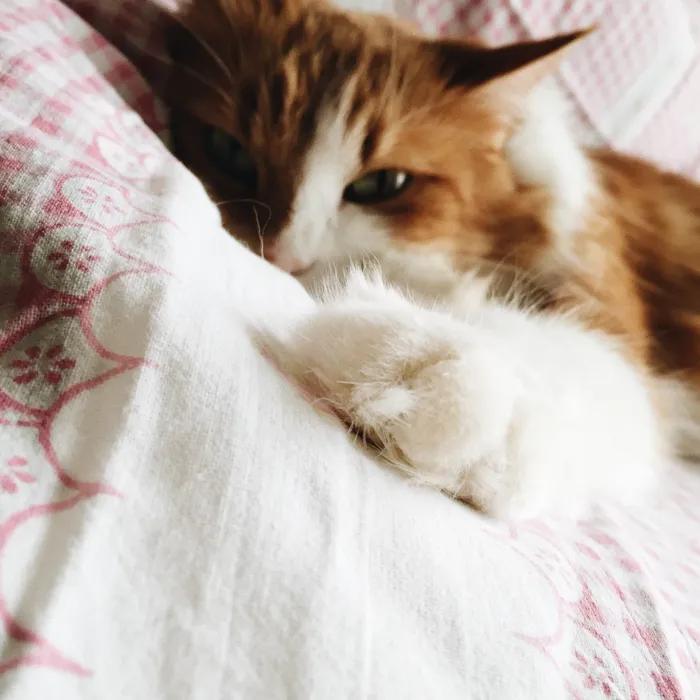How to repair upholstery damaged by cats

THERE are times when our feline friends have a tendency to test out their little claws on our upholstery, among other things. Picture: The Washington Post
By Jeanne Huber
Q: A family member's cat clawed all four edges of two sofas that I bought years ago. The cat pulled the threads badly, but it looks to me as if there aren't any holes. I love the pattern and colours of the fabric. I do not want to reupholster with a different fabric.
How can I repair or hide the damage? Should I trim the loose threads? If so, is there a type of glue for sewing that would make the stubble from the trimmed threads adhere smoothly to the fabric to make the damage less noticeable? Or do you have other solutions to suggest?
In today’s episode of I Have Junky Cats. pic.twitter.com/Dc9vKSRHVq
— Rumana Akoob (@RumanaAkoob) March 7, 2022
A: Given how much cats love to use sofa upholstery as scratching posts, it's probably no surprise that there is more than one approach to repairing the damage – or at least making it less noticeable.
In a case like yours, where there are loose threads but no visible tears, the best approach is to push the loose threads into the fabric, so they're hidden on the back. A felting needle is the ideal tool. It has no eye for thread; instead, it has a bend at one end, like an “L”, to help hold it in a handle, if one is used. The other end, which does the work, is pointed.
Just up from the tip are tiny ridges that act like barbs. Needlecraft artists use them to poke strands of wool together, causing them to tangle and interlock. With repeated poking, a wad of fibres becomes more compact and can be worked into three-dimensional felted shapes. For repairing upholstery, the ridges help push the loose threads through the fabric.
These needles come in different gauges, with higher numbers having smaller diameters. A 38-gauge needle ($12.99 – about R 199 – for three from Joann) should work well for most upholstery repairs. In a cross section, the ridged area may be triangular, star-shaped or spiral. The differences probably don't matter for upholstery repair.
With fairly sturdy upholstery, you will probably only have to push the loose fibres to the back. If there are many frayed fibres, you can work rapidly. Watch the process on YouTube in a video by Osiris & Friends, titled: “How to easily fix snagged upholstery caused by cat claws!”
With thin upholstery, though, you'll need to slow down and be more deliberate about where you poke, so you don't tear the fabric. Use a thinner needle, perhaps a 40-gauge. If the cat's claws (or your needlework) leave visible holes with frayed edges, seal the threads' ends with seam sealant, such as the Dritz Fray Check ($4.99 for a 0.75-ounce – about 22ml – bottle at Joann).
Instead of poking fibres to the back, some people recommend snipping off the loose fibres, then shaving the fabric with a razor, to shear off remaining frayed bits. Although this can give a quick like-new appearance to the upholstery, and it may work if the back of the upholstery is covered with a bonding layer, it weakens regular woven fabric and leaves it vulnerable to more serious damage if the cat continues to claw at it.
To treat situations where clawing creates holes, get a fabric glue, such as Tear Mender's instant fabric and leather adhesive or the Dritz Liquid Stitch (each $9.99 for a tube at Joann). If the hole is alongside a seam, spread a thin layer of glue on the seam allowance (the part of the fabric that will be hidden once the seam is closed), and press the seam closed with your fingers for a few minutes. If the seam allowance is frayed, first coat it with a bit of seam sealant, which will basically glue the threads to each other and make them stiffer, so it's easier to glue the seam back together.
Big holes in the middle of a section of upholstery need to be patched with fabric. If you don't have leftover fabric and if your sofa is set against a wall, you might be able to salvage patch material from the back, perhaps from the skirt, if your sofa has that type of upholstery. Otherwise, you might need to settle for a different fabric that matches the colour as closely as possible. If there's a pattern, you can touch up a plain fabric with permanent markers to achieve a similar look.
Although it's possible to glue a patch over a torn area, it's much tidier to have the patch material under the tear. Cut it oversize and slip the patch through the hole. Smooth out the patch, and trim any frayed threads around the tear. Squeeze glue onto a piece of paper, then lift the torn fabric and use a toothpick or other small tool to spread a thin layer of glue around the edge on the back.
If the fabric is fairly thin and you're worried the glue will bleed though, apply the glue to the patch material, after first outlining the perimeter of the hole (where you don't want to spread the glue) with a disappearing-ink fabric marker or chalk. Press the fabric down against the patch, and wait the recommended time on the label before putting stress on the fabric.
Once the repairs are done, prevent a new round of damage by placing a scratching post nearby and, possibly, purchasing sofa protectors. Some of these can wrap around the corners of the furniture and provide cats with a sacrificial covering that they're free to scratch. Others take the opposite approach and cover the corners with clear plastic, which cats typically don't find inviting to scratch.
Related Topics: